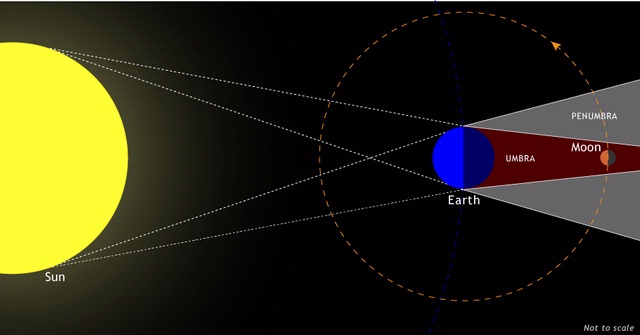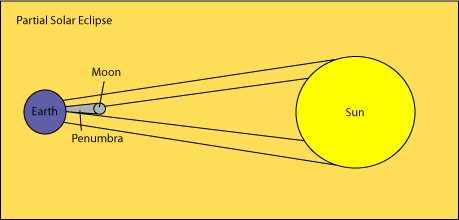As I am an enthusiast of all things related to celestial bodies, people often question me on the phenomenon known as a “lunar eclipse”. The enigma of these magnificent events is captivating and easy to view for anybody who looks to the sky. I love to inform people about these events, as this is what originally interested me in astronomy.

To the newest audience interested, a lunar eclipse occurs when the Earth casts a shadow on the moon. This is all relative to the position of the sun, in relation to the moon. Primarily, there are three types of lunar eclipses. Penumbral, Partial, and Total.
Penumbral Lunar Eclipse
Being the most unimpressive of the three, a penumbral eclipse can cause the moon to appear darker, or slightly discolored. The effects of this eclipse are typically faint, and hard to see, but it is an eclipse none the less. A penumbral eclipse occurs when the Earth’s penumbra (outer edge of shadow) is completely covering the moon. This is due to the alignment of the Earth, Sun, and moon being slightly offset.

Partial Lunar Eclipse
A partial Lunar Eclipse is most easily identified by the partial covering of the moon, hence the name. These eclipses can cause a varying amount of the moon to appear dark, with a portion still visible. They may also cause discoloration to an orange or dark gray. The causation of a partial eclipse is fairly similar to that of a penumbral eclipse.. The alignment of the Earth, Sun, and Moon are closer to a straight line, but still offset. This causes the umbra (darkest, central portion of shadow) of the Earth’s shadow to cover a portion of the moon.

Total Lunar Eclipse
One of the most captivating of the eclipses, a Total Lunar eclipse puts the moon into a deep red or orange state, giving it the nickname Blood Moon. This eclipse is fairly easy to recognize, and is remarkable for those who see it. This was the first eclipse I viewed, and I stayed awake all night to watch it. A Total Lunar eclipse occurs when the Earth, Sun, and Moon are in perfect alignment, and the moon is only illuminated by the light passing through Earth’s penumbra. The Earth’s umbra passes over the moon, and then, cover’s it entirely. You might think that the moon should be completely dark, but that’s where the penumbra comes into play The penumbra is not dark enough to restrict all light, and discolors the rays of the sun, creating an orange- red shade.

Lunar Eclipse Dates
*note: Times reference the time that the eclipse will be at it’s peak.
2016
March 23rd, 11:48:21, Penumbral Eclipse
September 16th, 18:55:27, Penumbral Eclipse
2017
February 11th, 0:45:03, Penumbral Eclipse
August 7th, 18:21:38, Partial Eclipse
2018
January 31st, 13:31:00, Total Eclipse
July 27th, 20:22:54, Total Eclipse
2019
January 21st, 5:13:27, Total Eclipse
July 16th, 21:31:55, Partial Eclipse
2020
January 10th, 19:11:11, Penumbral Eclipse
June 5th, 19:26:14, Penumbral Eclipse
July 5th. 04:31:12, Penumbral Eclipse
November 30th, 09:44:01, Penumbral Eclipse
How to View a Lunar Eclipse
While Lunar Eclipses are interesting to see, they are elusive to the viewer, and sometimes require some sort of safety preparation.
Preparation
Preparing to view a lunar eclipse is fairly easy. The main things that need to be factored are time and date, weather, and location. Ensure that you will be able to see the eclipse, and that your evening will not be ruined by clouds or rain. It should go without saying, but make sure you have the correct date. Nothing is worse than sitting out all night, and finding out you have the wrong date.
Safety
A lunar eclipse is not nearly as harmful to look at as a Solar eclipse, but still, you should always be cautious when viewing bright objects. Since a it can only occur during a full moon, you may be blinded by the power of the light. If you are using a telescope, it is recommended that you use a moon filter of some sort. Also, many lunar eclipses happen during colder months, or early mornings. Wear the appropriate clothing to stay comfortable
Equipment
Lunar eclipses are easy to see with the naked eye, but using the proper equipment can enhance the experience. Binoculars can be used to see some of the details in the lunar surface, as well as low power telescopes. No fancy equipment is necessary for eclipse photography. I have some amazing photographs taken with my iPhone. Since a lunar eclipse can only happen at night (obviously), a flashlight is a good idea to safely find your viewing position. Red light is very effective when trying to maintain night vision. In my opinion, the most important tool for viewing a lunar eclipse is a good alarm clock. It isn’t very fun to be completely prepared for an eclipse, and then waking up to find out you slept through it.
Overall, a lunar eclipse is an incredible spectacle for all astronomy enthusiasts. It is a safe, and excellent way to get involved with what space has to offer. And it is pretty effective at getting people hooked on celestial events, and acts as a gateway to watching other incredible things from the night sky.
Image Sources
https://airandspace.si.edu/webimages/640/WEB11715-2010_640.jpg
https://www.ecobuzzla.com/wp-content/uploads/2012/11/PenumbralLunarEclipse.jpg
https://www.mreclipse.com/LEphoto/TLE2000Jan/image/TLE2000-10w.JPG
https://astronomyonline.org/solarsystem/Images/Eclipse/PartialSolarEclipseDiagram.jpg
https://inapcache.boston.com/universal/site_graphics/blogs/bigpicture/lunar_eclipse_2011/bp1.jpg




